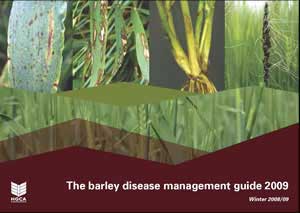 United
Kingdom United
Kingdom
December 18, 2008
This guide aims to provide barley
growers with up-to-date information on diseases that affect
their crop and options for control.
INTRODUCTION
Many diseases challenge the yield,
quality and hence
profitability of barley and so need to be controlled
effectively.
In the UK, barley crops range from September-sown,
6-row feed varieties to spring-sown, 2-row varieties for
malting. Regardless of variety, sowing date, location or
market, disease management in barley aims to maximise
grain numbers by protecting tillering and ear formation.
Too often disease management in barley is based on principles
established for wheat. However, the
two crops are fundamentally different and different approaches
to disease management are needed.
Barley yield depends on achieving high numbers of fertile ears
on a unit area of land; whereas wheat yield
depends on prolonging green canopy duration to fill the large
potential capacity of grains.
In barley, disease can affect growth and survival of both
tillers and spikelets, and a high initial plant count
is important. In contrast, wheat has a high capacity to
compensate for poor establishment and disease
seldom affects growth before flowering.
This guide aims to provide barley growers with up-to-date
information on diseases that affect their crop and options for
control.
Link:
http://www.hgca.com/publink.aspx?id=5036 |
|